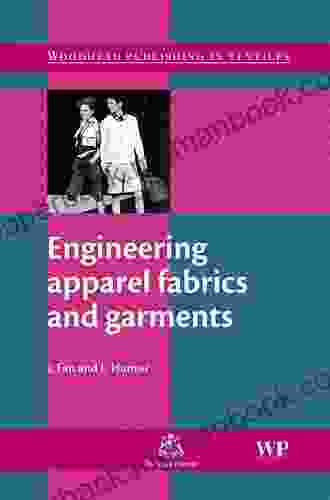Engineering Apparel Fabrics and Garments: A Comprehensive Guide to the Science of Clothing Design and Manufacture

4.6 out of 5
| Language | : | English |
| File size | : | 17196 KB |
| Text-to-Speech | : | Enabled |
| Enhanced typesetting | : | Enabled |
| Print length | : | 416 pages |
| Screen Reader | : | Supported |
Clothing is an essential part of our lives, and the fabrics and garments we wear play a significant role in our comfort, appearance, and overall well-being. The engineering of apparel fabrics and garments is a complex and multidisciplinary field that involves the application of science, technology, and design to create functional and aesthetically pleasing clothing.
This comprehensive guide provides a detailed overview of the engineering aspects of apparel fabrics and garments, covering topics such as:
* Fabric properties and performance * Garment construction and design * Textile testing methods * Clothing comfort and protection * Sustainable apparel engineering
Fabric Properties and Performance
The properties of a fabric are determined by the type of fibers used, the way the fibers are woven or knitted together, and the finishing treatments that are applied. The most important fabric properties include:
* Strength: The ability of a fabric to withstand force without tearing or breaking. * Elasticity: The ability of a fabric to stretch and return to its original shape. * Drape: The way a fabric falls and flows when worn. * Wrinkle resistance: The ability of a fabric to resist wrinkles and creases. * Moisture management: The ability of a fabric to absorb, transport, and release moisture. * Thermal insulation: The ability of a fabric to trap air and provide warmth.
The performance of a garment is directly related to the properties of the fabrics used in its construction. For example, a garment made from a strong and elastic fabric will be more durable and comfortable to wear than a garment made from a weak and inelastic fabric.
Garment Construction and Design
The construction of a garment refers to the way the individual pieces of fabric are sewn together. The design of a garment refers to the overall shape, style, and fit of the garment.
The construction of a garment is critical to its durability and comfort. A garment that is poorly constructed will be more likely to tear or come apart at the seams. The design of a garment is important for both aesthetic and functional reasons. A well-designed garment will be flattering to the wearer and will allow for a full range of motion.
Textile Testing Methods
Textile testing methods are used to evaluate the properties of fabrics and garments. These tests can be used to ensure that fabrics and garments meet the required standards for quality, performance, and safety.
Some of the most common textile testing methods include:
* Tensile strength testing: Measures the force required to break a fabric. * Tear strength testing: Measures the force required to tear a fabric. * Elasticity testing: Measures the ability of a fabric to stretch and return to its original shape. * Drape testing: Measures the way a fabric falls and flows when worn. * Wrinkle resistance testing: Measures the ability of a fabric to resist wrinkles and creases. * Moisture management testing: Measures the ability of a fabric to absorb, transport, and release moisture. * Thermal insulation testing: Measures the ability of a fabric to trap air and provide warmth.
Clothing Comfort and Protection
The comfort of a garment is determined by a number of factors, including the fabric properties, the garment construction, and the fit of the garment. Some of the most important factors for clothing comfort include:
* Breathability: The ability of a fabric to allow air to pass through it. * Moisture management: The ability of a fabric to absorb, transport, and release moisture. * Thermal insulation: The ability of a fabric to trap air and provide warmth. * Fit: The way a garment fits the wearer's body.
Clothing can also provide protection from the elements, such as wind, rain, and cold. The level of protection provided by a garment depends on the fabric used in its construction and the design of the garment.
Sustainable Apparel Engineering
Sustainability is becoming increasingly important in the apparel industry. Sustainable apparel engineering practices focus on reducing the environmental impact of the production, use, and disposal of clothing.
Some of the most important sustainable apparel engineering practices include:
* Using sustainable materials: Recycled fibers, organic cotton, and renewable materials. * Reducing waste: Minimizing fabric waste during production and promoting garment repair and reuse. * Improving energy efficiency: Using energy-efficient technologies in production and using renewable energy sources. * Reducing water consumption: Using water-saving technologies in production and designing garments that can be washed less often. * Promoting ethical production: Ensuring that clothing is produced in a safe and fair environment.
Engineering apparel fabrics and garments is a complex and challenging field, but it is also a rewarding one. By applying science, technology, and design, apparel engineers can create functional and aesthetically pleasing clothing that can improve our comfort, appearance, and overall well-being.
As the apparel industry continues to evolve, sustainable apparel engineering practices will become increasingly important. By adopting sustainable practices, apparel engineers can help to reduce the environmental impact of clothing and create a more sustainable future for the fashion industry.
4.6 out of 5
| Language | : | English |
| File size | : | 17196 KB |
| Text-to-Speech | : | Enabled |
| Enhanced typesetting | : | Enabled |
| Print length | : | 416 pages |
| Screen Reader | : | Supported |
Do you want to contribute by writing guest posts on this blog?
Please contact us and send us a resume of previous articles that you have written.
 Top Book
Top Book Novel
Novel Fiction
Fiction Nonfiction
Nonfiction Literature
Literature Paperback
Paperback Hardcover
Hardcover E-book
E-book Audiobook
Audiobook Bestseller
Bestseller Classic
Classic Mystery
Mystery Thriller
Thriller Romance
Romance Fantasy
Fantasy Science Fiction
Science Fiction Biography
Biography Memoir
Memoir Autobiography
Autobiography Poetry
Poetry Drama
Drama Historical Fiction
Historical Fiction Self-help
Self-help Young Adult
Young Adult Childrens Books
Childrens Books Graphic Novel
Graphic Novel Anthology
Anthology Series
Series Encyclopedia
Encyclopedia Reference
Reference Guidebook
Guidebook Textbook
Textbook Workbook
Workbook Journal
Journal Diary
Diary Manuscript
Manuscript Folio
Folio Pulp Fiction
Pulp Fiction Short Stories
Short Stories Fairy Tales
Fairy Tales Fables
Fables Mythology
Mythology Philosophy
Philosophy Religion
Religion Spirituality
Spirituality Essays
Essays Critique
Critique Commentary
Commentary Glossary
Glossary Bibliography
Bibliography Index
Index Table of Contents
Table of Contents Preface
Preface Introduction
Introduction Foreword
Foreword Afterword
Afterword Appendices
Appendices Annotations
Annotations Footnotes
Footnotes Epilogue
Epilogue Prologue
Prologue James D Shipman
James D Shipman Pete Castillo
Pete Castillo Whitney Rio Ross
Whitney Rio Ross Leslie Schrock
Leslie Schrock Olivia Gatwood
Olivia Gatwood Darren West
Darren West Morgan St James
Morgan St James Benjamin Gilmour
Benjamin Gilmour Matti Charlton
Matti Charlton John Van Dreal
John Van Dreal Kristen Thrasher
Kristen Thrasher Dr Rose Ajimatanrareje
Dr Rose Ajimatanrareje Guy Blaze
Guy Blaze Robert B Gordon
Robert B Gordon Sara Rosett
Sara Rosett Nancy Silverton
Nancy Silverton Louis Becke
Louis Becke Cj Hernley
Cj Hernley Kindle Edition
Kindle Edition Sara Driscoll
Sara Driscoll
Light bulbAdvertise smarter! Our strategic ad space ensures maximum exposure. Reserve your spot today!
 John GrishamFollow ·2.3k
John GrishamFollow ·2.3k Junot DíazFollow ·14k
Junot DíazFollow ·14k Colin FosterFollow ·17k
Colin FosterFollow ·17k Julio Ramón RibeyroFollow ·16.5k
Julio Ramón RibeyroFollow ·16.5k Percy Bysshe ShelleyFollow ·4.3k
Percy Bysshe ShelleyFollow ·4.3k Matthew WardFollow ·10.9k
Matthew WardFollow ·10.9k Josh CarterFollow ·2.7k
Josh CarterFollow ·2.7k Kirk HayesFollow ·9.2k
Kirk HayesFollow ·9.2k

 Jeremy Mitchell
Jeremy MitchellPlay We Now On Christmas Violin Christmas: A Heartfelt...
Play We Now On...

 Terry Bell
Terry BellTales from the Road: Confessions of an Atlanta Uber...
In the vibrant...

 Ervin Bell
Ervin BellThe French Admiral: A Gripping Naval Adventure with Alan...
In the vast expanse of...

 Henry David Thoreau
Henry David ThoreauCrochet Cozy Afghan Patterns: Crochet Weekend Afghan...
to Crochet...

 Orson Scott Card
Orson Scott CardAn Archaeological View Of The Industrialization Of North...
The industrialization of North America was a...

 Josh Carter
Josh CarterClipboard Christmas Skits by Tom Spence: A Festive...
A Christmas...
4.6 out of 5
| Language | : | English |
| File size | : | 17196 KB |
| Text-to-Speech | : | Enabled |
| Enhanced typesetting | : | Enabled |
| Print length | : | 416 pages |
| Screen Reader | : | Supported |










